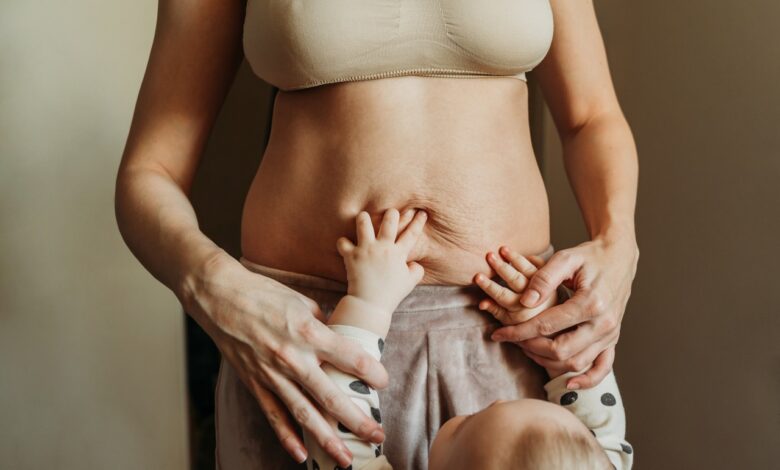How To Accelerate Weight Loss After C-section- HealthifyMe

Welcoming a new life into the world through pregnancy and childbirth is a momentous occasion for every woman. Sometimes, circumstances may lead to a C-section, an alternative to vaginal delivery. However, the road to weight loss after a C-section can be more challenging than vaginal delivery. Factors such as an extended recovery period, hormonal fluctuations, abdominal muscle separation, discomfort, and breastfeeding obstacles can make shedding those extra pounds seem like an uphill battle.
To commence a successful weight loss journey after a C-section, a new mom must prioritise a healthy diet and regular exercise. However, the most essential part is patience. Before initiating any weight loss program, seeking guidance from a health coach who can offer tailored strategies and support is advisable.
Immediately after a C-section delivery, the new mom should focus on rest, nourishment, and optimal care for her newborn. By adhering to a few simple health guidelines and embracing patience, the natural weight loss process will gradually unfold over time, empowering her to regain her pre-pregnancy shape and transform from flab to fab.
When to Begin the Weight Loss Journey after a C Section Delivery?
Data shows that during pregnancy, it is common for women with a normal pre-pregnancy BMI to gain around 25 to 35 pounds (11.5 to 16 kilograms). However, the weight gain may vary depending on the mother’s pre-pregnancy weight, diet, and overall health.
Before embarking on the postpartum weight loss journey following a C-section, it is crucial to recognise that it is a major surgical procedure requiring ample rest and recovery time. Therefore, one must consult a doctor before losing weight after a C-section.
C-section deliveries often involve more pain and discomfort compared to vaginal deliveries, which can make it challenging for new moms to engage in regular activities that aid in weight loss. In addition, the physical discomfort and emotional stress associated with the recovery process may also contribute to overeating or unhealthy eating habits. Consequently, it is essential to prioritise self-acceptance and embrace the changes that accompany this new phase of life.
The weight loss process after a C-section typically begins around six to eight weeks after delivery, once the incisions have fully healed. Initiating weight loss earlier than this timeframe may hinder post-pregnancy recovery. For instance, reducing calorie intake for weight loss purposes could lead to weakness in the mother and potentially impact her nutritional status, particularly if she is breastfeeding. Additionally, engaging in strenuous exercises too soon may risk reopening the C-section incisions.
Achieving successful weight loss after a C-section involves following a healthy diet, incorporating regular exercise, and making overall lifestyle choices that promote well-being.
Summary
On average, women gain around 10-16 kilograms of weight during pregnancy, although individual weight gain may vary. The weight loss journey after a C-section delivery should commence only after six to eight weeks, allowing for complete healing of the incisions and ensuring that the new mother has had sufficient time to recover and rest. Follow the guidance provided by a doctor throughout the weight loss process.
Foods to Eat for Weight Loss after C section
Eating the right foods is crucial in replenishing the body with essential nutrients after a C-section delivery and aiding in weight loss. Including specific food items can facilitate recovery and promote healthy weight reduction.
Whole Grain Foods
Opt for whole-grain foods like oats, whole-wheat, millet, and brown rice. Investigations show that these foods are rich in iron, folic acid, and fibre, providing vital vitamins and nutrients. Additionally, they boost energy levels and help maintain a healthy breast milk supply.
Vitamins
Leafy green vegetables such as fenugreek leaves, broccoli, spinach, and lotus stem are excellent sources of vitamins A, C, calcium, and iron. Research shows these vitamins support collagen production, skin regeneration, and tissue healing. Citrus fruits like oranges are also beneficial, as they contain vitamin C and antioxidants, which are particularly advantageous for breastfeeding mothers.
Fruits and Vegetables
Include fruits and vegetables like papaya, watermelon, orange, strawberry, blueberry, grapefruit, and sweet potato. These foods possess infection-fighting properties and strengthen the immune system. Therefore, fresh produce should be an essential part of the post-C-section diet.
Proteins
Research shows that protein-rich foods aid tissue repair, promote healing, and maintain muscle strength after delivery. Non-vegetarian options such as eggs, chicken, meat, and fish are excellent protein sources. In addition, vegetarians can obtain protein requirements from nuts, dried beans, dairy products, peas, carrots, dates, mushrooms, pulses, and legumes.
Iron-rich Foods
Iron-rich foods are crucial after a C-section delivery. Research shows that iron helps replenish haemoglobin levels, restore blood lost during delivery, and improve immunity. Some iron-rich foods are red meat, oysters, egg yolks, leafy green vegetables, and dried fruits.
High-Fibre Foods
Incorporate fibre-rich foods into the diet to regulate bowel movements and prevent constipation. These include raw fruits, vegetables, oats, ragi, lentils, pulses, and green grams.
Dairy Products
Milk, curd, cheese, and cottage cheese provide nursing mothers with calcium, protein, vitamin B, and vitamin D. Calcium-fortified drinks like milk and low-fat yoghurt are beneficial for stimulating breast milk supply.
Fluids
Maintaining hydration is essential after a C-section delivery to aid in quicker recovery and prevent constipation. Consume fluids like water, coconut water, buttermilk, soup, low-fat milk, herbal teas, and fresh non-citrus juices.
Indian Spices
Indian spices offer additional benefits that assist new mothers in coping with the physical demands of childbirth. Carom seeds or ajwain possess antiseptic, antioxidant, antibacterial, and anti-fungal properties, aiding digestion and pain relief. Cumin or jeera acts as a lactating agent, enhancing breast milk supply and aiding digestion. Turmeric acts as an anti-inflammatory substance and helps boost breast milk supply. Asafoetida or hing relieves gastrointestinal problems and aids digestion.
Summary
A diet rich in proteins, vitamins, fibre, and iron is crucial for post-C-section recovery and weight loss. In addition, incorporating fresh fruits, vegetables, Indian spices, and whole-grain foods into the diet promotes rapid healing and aids in shedding extra pounds. Adequate hydration is equally vital in the post-C-section phase.
Foods to Avoid After C section Delivery
Maintaining a healthy diet is vital in facilitating weight loss after a C-section delivery. By being mindful of their food choices during this crucial period, new mothers can improve their overall health and support their weight loss goals. So let’s look at the types of foods to avoid.
Processed or Junk Food
Steering clear of processed, junk, and fried foods is crucial. These foods are high in calories, salt, sugar, and unhealthy fats. Consuming such foods hampers weight loss efforts and can result in acidity and unwanted weight gain.
Carbonated Drinks and Citrus Juices
Limit the intake of carbonated drinks, as they contain excessive sugar. Moreover, these beverages can adversely affect the mother’s health and the baby’s growth. Citrus juices may also lead to gas and flatulence, so it is best to consume them in moderation.
Sugary and Refined Foods
Avoid foods with added sugar as they can cause rapid spikes in blood sugar levels, potentially leading to weight gain and insulin resistance. Instead of indulging in sugary treats, it is advisable to replace them with fruits, which provide natural sugars along with the added benefits of fibre and essential nutrients. Dry fruits can also be a nutritious alternative.
Caffeine
While relying on caffeine for an energy boost may be tempting, avoiding or limiting caffeine-containing beverages like tea, coffee, energy drinks, and soft drinks is recommended. Excessive caffeine intake can adversely affect the mother’s well-being and the baby’s growth, making moderation the key.
Alcohol and Smoking
It is crucial to avoid alcohol consumption during this period, as it can affect the mother’s overall health and impacts her breast milk supply. Similarly, one should strictly avoid smoking as it poses similar risks and hampers recovery after a C-section.
Summary
Steering clear of sugary foods, processed or junk foods, carbonated drinks, excessive caffeine, alcohol, and smoking is essential for new mothers seeking a successful weight loss journey after a C-section delivery. They can optimise their recovery and pave the way for sustainable weight loss by making informed choices and prioritising a nourishing diet.
Reference Meal Plan
Here is a 3-day reference meal plan to lose weight after a C-section:
Day 1
- Early Morning: One glass of milk + A handful of mixed nuts
- Breakfast: Whole wheat toast + Scrambled eggs with veggies
- Lunch: Brown rice + Mixed greens dal + Cucumber raita
- Evening Snack: Fruit shake + Roasted soybeans
- Dinner: Chapati + Dal + Vegetable salad + Garlic tomato chutney
- Bedtime: One glass of milk
Day 2
- Early Morning: One glass of milk + A handful of mixed nuts
- Breakfast: Oatmeal with fruits and nuts
- Lunch: Quinoa salad with grilled chicken or tofu
- Evening Snack: Greek yoghurt with berries
- Dinner: Grilled fish or tofu + Steamed vegetables + Whole wheat bread
- Bedtime: One glass of milk
Day 3
- Early Morning: One glass of milk + A handful of mixed nuts
- Breakfast: Whole wheat pancakes with banana and almond butter
- Lunch: Lentil soup + Grilled Tofu & Veggies
- Evening Snack: Vegetable sticks with hummus
- Dinner: Grilled chicken breast or paneer + Whole wheat pasta and veg salad
- Bedtime: One glass of milk
Remember that weight loss should be gradual to avoid impacting breastfeeding. The above mentioned meal plan includes high-protein and moderate-fat options from healthy sources. Regarding exercise, starting with walks and gradually increasing exercise intensity under the guidance of an expert is advisable.
Remember to consult a healthcare expert or a certified nutritionist before starting any weight loss program after a C-section to ensure it aligns with your needs and health status.
Tips for Weight Loss after C Section
A Few Dietary Tips for Weight Loss after C Section
Implementing certain dietary changes can make a significant difference in losing weight after a C-section effectively. Consider the following tips:
- Opt for Frequent, Smaller Meals: Instead of consuming three large meals, aim for five to six smaller meals throughout the day. This approach helps regulate blood sugar levels, boosts metabolism, and prevents excessive hunger.
- Mind the Meal Gaps: Maintain a 2-3 hour gap between meals. If hunger strikes between meals, choose healthy snacks like dry fruits or fresh fruit to stabilise your energy levels.
- Embrace Homemade Meals: Prioritise freshly prepared home-cooked meals over eating out. Doing so gives you better control over the ingredients, portion sizes, and overall nutritional value of your meals.
- Avoid Foods That Cause Discomfort: Steer clear of foods that can lead to constipation or gas. Identifying and eliminating triggers like spicy foods, processed snacks, carbonated drinks, and high-fat items can help prevent discomfort and support your weight loss efforts.
Other Lifestyle Tips for Weight Loss and Good Health after a C-Section
Besides a healthy diet, lifestyle changes can further aid in weight loss and overall well-being after a C-section delivery. Here are some additional tips to consider:
Embrace the Postpartum Phase: Recognise and appreciate this unique phase of motherhood. Be patient and gentle with yourself while focusing on weight loss. Remember, it takes time for your body to recover, and with proper dietary and lifestyle interventions, you can gradually return to your pre-pregnancy weight within 6-12 months.
Harness the Power of Breastfeeding: Besides being beneficial to the baby, breastfeeding assists in weight loss. Breastfeeding helps burn approximately 250 to 500 calories daily.
Explore the Benefits of Postnatal Massage: Around two weeks after a C-section delivery or once the scar has fully healed, consider incorporating postnatal massages into your routine. These massages help release fluids from the lymph nodes, promote weight loss, reduce body swelling, improve blood circulation and oxygen supply, boost immunity, and facilitate a quicker recovery.
Engage in Gentle Exercise: After a C-section, allowing sufficient time for your body to heal is crucial. Once you’ve received clearance from your healthcare provider (usually after six weeks), gradually introduce mild to moderate exercises, such as walking. Aim for 20-30 minutes of walking slowly to moderately. Additionally, consider incorporating yoga into your routine with guidance from a health coach or doctor.
Prioritise Sleep: Although maintaining a regular sleep pattern can be challenging with a newborn, strive to get six to eight hours of sleep daily. Adequate sleep enhances your emotional and physical well-being and supports weight loss efforts.
Consider Belly Binding: Belly binding involves using a muslin cloth or a postpartum girdle to wrap the abdomen tightly. This practice aids in tightening the abdominal muscles, reducing the appearance of a hanging belly, and ensuring complete healing of the C-section incision. Seek guidance from your healthcare provider before engaging in belly binding.
Summary
Eating freshly prepared home-cooked meals, opting for smaller and more frequent meals, maintaining meal gaps of two to three hours, and avoiding foods that cause discomfort are key dietary strategies for weight loss after a C-section. Successful weight loss after a C-section involves careful planning and perseverance. Implementing a healthy diet, engaging in regular exercise after recovery,
Just Saying
Did you know drinking lemon water following C-section delivery is one of the safest ways to detox and eliminate excess belly fat? Add some lemon juice and honey to lukewarm water and drink it early in the morning. This combination helps in melting fat and decreasing tummy after a C-section delivery. However, ensure you do not drink this lemon water more than once daily. Unfortunately, excess consumption can lead to acidity and related complications.
The Final Word
Embarking on a weight loss journey after a C-section can be challenging but with the right approach, it is possible to achieve one’s goals. By prioritising a healthy diet, regular exercise, and patience, new moms can gradually regain their pre-pregnancy shape and transform from flab to fab. Consult a healthcare expert or a certified nutritionist before commencing a weight loss program to ensure it aligns with individual needs and health status. Remember, the journey may take time, but with perseverance and self-care, success is within reach.
Disclaimer: The purpose of this article is just to disperse knowledge and raise awareness. It does not intend to replace medical advice from professionals. For further information, please contact our certified nutritionists Here.
Frequently Asked Questions (FAQs)
Q: How soon after a C-section can I start exercising for weight loss?
A: After a C-section, it is advisable to wait around six to eight weeks before starting any exercise regimen for weight loss. This time frame allows for the complete healing of the incisions and reduces the risk of reopening them. However, doing weight loss exercises too soon may hinder post-pregnancy recovery and cause weakness. Therefore, consulting with a doctor before beginning any exercise program is essential to ensure it is safe for your specific situation.
Q: Is it safe to diet for weight loss immediately after a C-section?
A: It is not advisable to initiate weight loss before six to eight weeks after delivery. Reducing calorie intake for weight loss purposes could lead to weakness in the mother and potentially impact her nutritional status, particularly if breastfeeding.
Q: Can breastfeeding help me lose weight after a C-section?
A: Breastfeeding can help with weight loss after a C-section since it burns calories and helps reduce belly fat. However, it is crucial to maintain a healthy diet while breastfeeding to ensure that the mother and baby are receiving adequate nutrients.
Q: How long does it take to lose weight after a C-section?
A: The time it takes to lose weight after a C-section varies depending on several factors, including the mother’s pre-pregnancy weight, overall health, diet, and exercise regimen. Aiming for gradual and sustainable weight loss rather than rapid weight loss is advisable.
Q: Are there any specific exercises that can help me lose weight after a C-section?
A: Low-impact exercises such as walking, yoga, and stretching are ideal for new moms who have undergone C-sections. These exercises help tone the abdominal muscles, promote blood circulation, and improve overall health.
Q: Should I consult a doctor before starting any weight loss program after a C-section?
A: It is crucial to consult a doctor before starting any weight loss program after a C-section. C-section deliveries are major surgical procedures that require ample rest and recovery time. Therefore, a doctor’s guidance can ensure the mother is safe and healthy during the weight loss journey.
Q: Can I undergo weight loss surgery after a C-section?
A: It is not advisable to undergo weight loss surgery immediately after a C-section. The body needs time to recover from the C-section procedure; weight loss surgery could lead to complications and delayed recovery. Instead, one should opt for sustainable measures like healthy eating and lifestyle changes.
Q: How can I manage my diet to lose weight after a C-section?
A: A healthy diet after a C-section should include whole-grain foods, vitamins, fruits, vegetables, proteins, iron-rich foods, and high-fibre foods. A diet rich in these nutrients will help replenish the body with essential nutrients, aid in recovery, and promote healthy weight loss.
Q: What are the risks of rapid weight loss after a C-section?
A: Rapid weight loss after a C-section can lead to weakness, malnutrition, dehydration, and other health complications. Aiming for gradual and sustainable weight loss is advisable to ensure the body is healthy and recovers appropriately.
Q: Can stress hinder my weight loss after a C-section?
A: Yes, stress can hinder weight loss after a C-section. The physical discomfort and emotional stress associated with the recovery process may contribute to overeating or unhealthy eating habits, hampering weight loss. Therefore, it is essential to prioritise self-acceptance and embrace the changes that come with this new phase of life to reduce stress levels.
Research Sources
1. Centres for Disease Control and Prevention
https://www.cdc.gov/reproductivehealth/maternalinfanthealth/pregnancy-weight-gain.htm
2. DePhillipo NN, Aman ZS, Kennedy MI, Begley JP, Moatshe G, LaPrade RF. Efficacy of Vitamin C Supplementation on Collagen Synthesis and Oxidative Stress After Musculoskeletal Injuries: A Systematic Review. Orthop J Sports Med. 2018 Oct 25;6(10):2325967118804544. DoI: 10.1177/2325967118804544. PMID: 30386805; PMCID: PMC6204628.
https://www.ncbi.nlm.nih.gov/pmc/articles/PMC6204628/
3. Pesta DH, Samuel VT. A high-protein diet for reducing body fat: mechanisms and possible caveats. Nutr Metab (Lond). 2014 Nov 19;11(1):53. DoI: 10.1186/1743-7075-11-53. PMID: 25489333; PMCID: PMC4258944.
https://www.ncbi.nlm.nih.gov/pmc/articles/PMC4258944/#CR8
4. Guideline: Iron Supplementation in Postpartum Women. Geneva: World Health Organization; 2016. BACKGROUND. Available from: https://www.ncbi.nlm.nih.gov/books/NBK379991/




